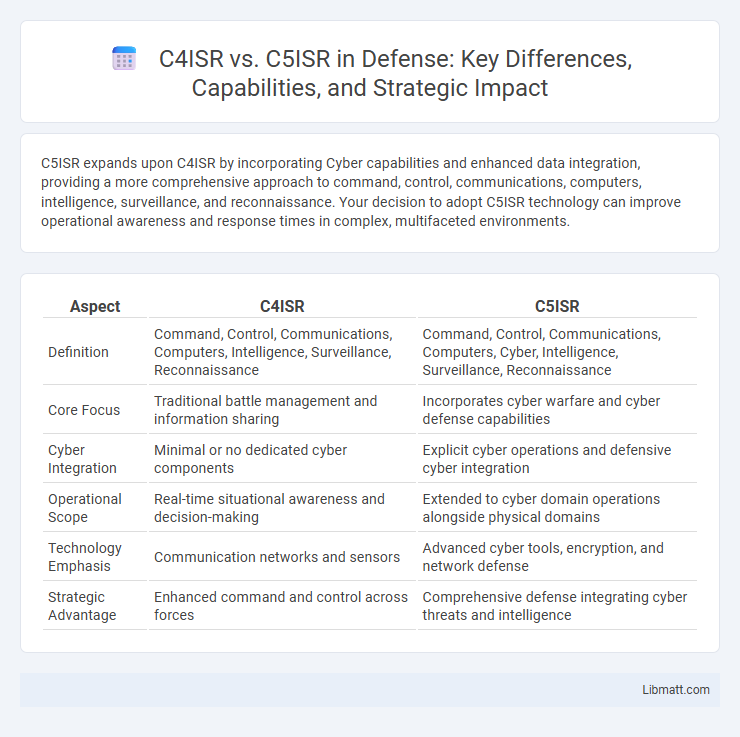C5ISR expands upon C4ISR by incorporating Cyber capabilities and enhanced data integration, providing a more comprehensive approach to command, control, communications, computers, intelligence, surveillance, and reconnaissance. Your decision to adopt C5ISR technology can improve operational awareness and response times in complex, multifaceted environments.
Table of Comparison
| Aspect | C4ISR | C5ISR |
|---|---|---|
| Definition | Command, Control, Communications, Computers, Intelligence, Surveillance, Reconnaissance | Command, Control, Communications, Computers, Cyber, Intelligence, Surveillance, Reconnaissance |
| Core Focus | Traditional battle management and information sharing | Incorporates cyber warfare and cyber defense capabilities |
| Cyber Integration | Minimal or no dedicated cyber components | Explicit cyber operations and defensive cyber integration |
| Operational Scope | Real-time situational awareness and decision-making | Extended to cyber domain operations alongside physical domains |
| Technology Emphasis | Communication networks and sensors | Advanced cyber tools, encryption, and network defense |
| Strategic Advantage | Enhanced command and control across forces | Comprehensive defense integrating cyber threats and intelligence |
Introduction to C4ISR and C5ISR
C4ISR (Command, Control, Communications, Computers, Intelligence, Surveillance, and Reconnaissance) integrates military operations by enhancing real-time situational awareness and decision-making capabilities. C5ISR expands this framework by adding Cyber and Combat capabilities, addressing emerging threats in cyber warfare and automated combat systems. Understanding these advanced systems is crucial for improving your defense strategy and operational efficiency.
Defining C4ISR: Components and Capabilities
C4ISR, which stands for Command, Control, Communications, Computers, Intelligence, Surveillance, and Reconnaissance, integrates these components to provide comprehensive situational awareness and decision-making support in military operations. It encompasses advanced communication systems, data processing units, and intelligence-gathering sensors that enable real-time information flow between commanders and units. The primary capabilities of C4ISR include efficient command execution, enhanced battlefield communication, and accurate intelligence analysis for effective operational control.
What’s New in C5ISR?
C5ISR integrates Cyber and Combat capabilities into the traditional Command, Control, Communications, Computers, Intelligence, Surveillance, and Reconnaissance framework, enhancing operational effectiveness through real-time data fusion and advanced cyber defense. The inclusion of Cyber operations addresses emerging threats in the digital domain, while Combat capabilities support direct action coordination on the battlefield. Your military decision-making benefits from this comprehensive, interconnected system that improves situational awareness and response agility.
Key Differences Between C4ISR and C5ISR
C4ISR (Command, Control, Communications, Computers, Intelligence, Surveillance, and Reconnaissance) primarily focuses on integrating military capabilities for situational awareness and decision-making. C5ISR adds the fifth "C" representing Cyber, emphasizing cybersecurity and cyber warfare alongside traditional ISR functions. Your understanding of C5ISR highlights its enhanced emphasis on protecting information networks and countering cyber threats in modern defense operations.
The Role of Cybersecurity in C5ISR
Cybersecurity plays a pivotal role in C5ISR by safeguarding the interconnected networks and data flows essential for command, control, communications, computers, intelligence, surveillance, reconnaissance, and cyber elements. Unlike C4ISR, C5ISR integrates cyber operations as a core component, emphasizing real-time threat detection, network resilience, and protection against cyberattacks to ensure operational continuity. This enhanced cybersecurity framework supports decision-making processes by maintaining the integrity, confidentiality, and availability of critical military information systems.
Operational Benefits of C5ISR Over C4ISR
C5ISR enhances traditional C4ISR capabilities by integrating cyber operations, providing superior situational awareness and quicker decision-making in complex threat environments. This advanced system improves real-time data fusion and communication resilience, ensuring Your forces maintain operational superiority against evolving cyber and electronic warfare threats. The added cyber dimension significantly reduces vulnerabilities, facilitating more effective mission execution and adaptive responses.
Technology Integration: From C4ISR to C5ISR
Technology integration in C4ISR centers on Command, Control, Communications, Computers, Intelligence, Surveillance, and Reconnaissance systems working in tandem to enhance battlefield situational awareness and decision-making. The shift to C5ISR introduces Cybersecurity as a critical component, ensuring secure, resilient communication and data networks against growing cyber threats. This evolution reflects an advanced fusion of information technology and cyber defense capabilities, enabling seamless, secure information flow and operational effectiveness in modern military environments.
Challenges in Upgrading to C5ISR
Upgrading from C4ISR (Command, Control, Communications, Computers, Intelligence, Surveillance, and Reconnaissance) to C5ISR introduces challenges such as integrating cybersecurity measures within existing communication and data frameworks, ensuring interoperability across diverse platforms, and managing the increased complexity of real-time data processing. Your systems must adapt to incorporate cyber defense capabilities without compromising operational efficiency, requiring substantial investment in advanced technologies and specialized personnel training. Addressing these challenges is critical to maintaining situational awareness and operational superiority in modern warfare environments.
Real-World Applications: C4ISR vs C5ISR
C4ISR systems integrate Command, Control, Communications, Computers, Intelligence, Surveillance, and Reconnaissance to support military decision-making and battlefield awareness, heavily relying on real-time data from diverse sensors and communication networks. C5ISR expands upon C4ISR by incorporating Cybersecurity, enhancing protection against cyber threats and ensuring the integrity of command and control systems in increasingly contested environments. Real-world applications of C5ISR include securing critical infrastructure, cyber defense operations, and enabling resilient communications in multi-domain operations, reflecting the evolving nature of modern warfare challenges.
Future Trends and Evolution of ISR Systems
Future trends in ISR systems highlight the shift from C4ISR (Command, Control, Communications, Computers, Intelligence, Surveillance, and Reconnaissance) to C5ISR by integrating Cybersecurity as a critical component. The evolution emphasizes enhancing real-time data fusion, artificial intelligence, and automated decision-making to improve situational awareness and operational responsiveness. Your ability to adapt to these advancements ensures superior threat detection and mission success in increasingly complex environments.
C4ISR vs C5ISR Infographic

 libmatt.com
libmatt.com